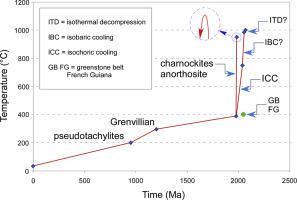Geoscience Frontiers ( IF 8.5 ) Pub Date : 2020-08-16 , DOI: 10.1016/j.gsf.2020.05.021 Frank F. Beunk , Emond W.F. de Roever , Keewook Yi , Fraukje M. Brouwer

|
We constrain the multistage tectonic evolution of the Palaeoproterozoic UHT metamorphic (P = 0.9–1.0 GPa, T >1000 °C, t = 2088–2031 Ma) Bakhuis Granulite Belt (BGB) in Surinam on the Guiana Shield, using large- to small-scale structures, Al-in-hornblende thermobarometry and published fluid inclusion and zircon geochronological data. The BGB forms a narrow, NE–SW striking belt between two formerly connected, ~E–W oriented granite-greenstone belts, formed between converging Amazonian and West African continental masses prior to collision and Transamazonian orogeny. Inherited detrital zircon in BGB metasediments conforms agewise to Birimian zircon of West Africa and suggests derivation from the subsequently subducted African passive margin. Ultrahigh-temperature metamorphism may have followed slab break-off and asthenospheric heat advection. Peak metamorphic structures result from layer-parallel shearing and folding, reflecting initial transtensional exhumation of the subducted African margin after slab break-off. A second HT event involves intrusion, at ca. 0.49 GPa, of charnockites and metagabbros at 1993–1984 Ma and a layered anorthosite at 1980 Ma, after the BGB had already cooled to <400 °C. The event is related to northward subduction under the greenstone belts, along a new active margin to their south. A pronounced syntaxial bend in the new margin points northward towards the BGB and is likely the result of indentation by an anticlinorial flexural bulge of the subducting plate. Tearing of the subducting oceanic plate along this bulge explains why the charnockites are restricted to the BGB. The BGB subsequently experienced doming under an extensional detachment exposed in its southwestern border zone. Exhumation was focused in the BGB as a result of the flexural bulge in the subducting plate and localised heating of the overriding plate by charnockite magmatism. The present, straight NE–SW long-side boundaries of the BGB are superimposed mylonite zones, overprinted by pseudotachylites, previously dated at ca. 1200 Ma and 950 Ma, respectively. The 1200 Ma mylonites reflect transpressional popping-up of the BGB, caused by EW-directed intraplate principal compressive stresses from Grenvillian collision preserved under the eastern Andes. Further exhumation of the BGB involved the 950 Ma pseudotachylite decorated faulting, and Phanerozoic faulting along reactivated Meso- and Neoproterozoic lineaments.
中文翻译:

苏里南圭亚那盾构超高温Bakhuis花岗岩带的结构和构造热演化:古元古代至近代
我们限制了古元古代UHT变质的多阶段构造演化(P = 0.9–1.0 GPa,T > 1000°C,t= 2088–2031 Ma)位于圭亚那盾构苏里南的Bakhuis花岗岩带(BGB),使用了从大到小的结构,铝角闪闪热压法,并公布了流体包裹体和锆石的年代学数据。BGB在两个先前相连的,〜E-W方向的花岗岩-绿岩带之间形成了一条狭窄的NE-SW冲击带,形成于碰撞前的亚马逊河和西非大陆块之间以及Transamazonian造山运动之间。BGB沉积物中继承的碎屑锆石在年龄上与西非的Birimian锆石相符,并暗示其源自随后被俯冲的非洲被动缘。平板破裂和软流圈热对流可能是超高温变质作用。峰变质结构是由平行层剪切和折叠形成的,反映了板块断裂后被俯冲的非洲边缘的初始张性发掘。第二个HT事件涉及在。在BGB已冷却至< 0.45 GPa时,在1993–1984 Ma时有蛇眼石和变辉岩,在1980 Ma时有层状的钙硅钙石。400℃。该事件与绿岩带下向北俯冲有关,沿着其南部的新活动边缘。新边缘的明显句法弯曲向北指向BGB,这很可能是俯冲板的反气候弯曲凸起造成的压痕的结果。沿该隆起的俯冲洋板的撕裂解释了为何夏诺克岩仅限于BGB。BGB随后在其西南边界地区暴露出来的一个扩展支队下经历了隆起。由于俯冲板中的弯曲隆起和夏诺岩岩浆作用对上覆板的局部加热,使尸体发掘集中在了BGB中。目前,BGB的直线NE-SW长边边界是叠合的镍铁矿带,由假速滑石叠印,以前的年代大约为。分别为1200 Ma和950 Ma。1200 Ma的Mylonites反映了BGB的超压弹起,这是由EW定向板内主压应力引起的,该压应力来自保留在安第斯山脉东部的格伦维利冲撞。BGB的进一步发掘涉及950 Ma的假速闪石装饰断层,以及沿重新活化的中元古界和新元古界的古生代断裂。











































 京公网安备 11010802027423号
京公网安备 11010802027423号